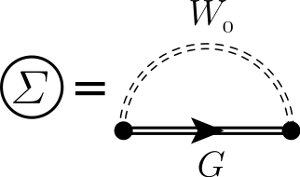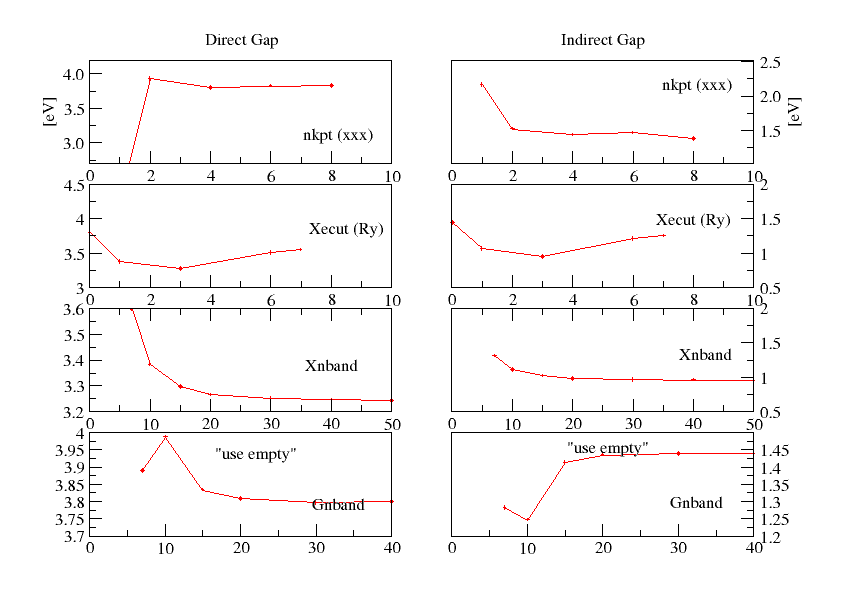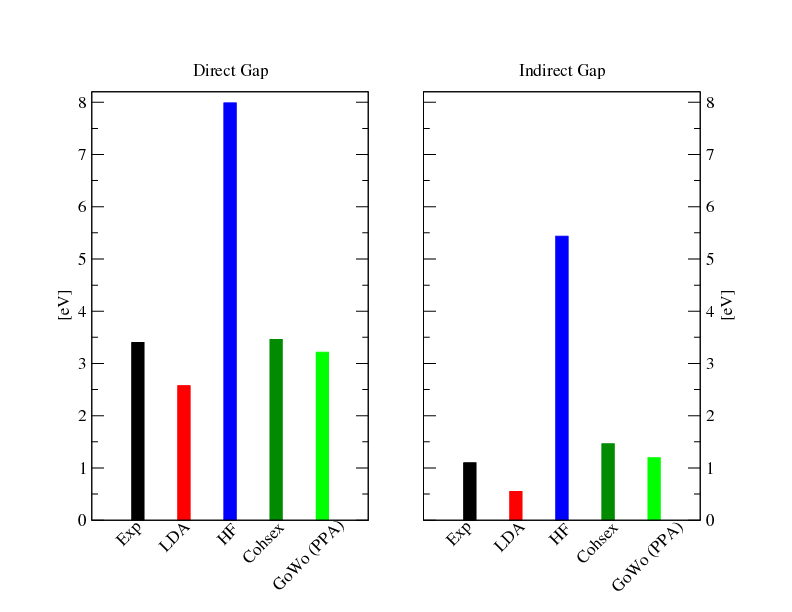Hartree Fock and GW: Difference between revisions
No edit summary |
|||
| (5 intermediate revisions by 2 users not shown) | |||
| Line 30: | Line 30: | ||
Once the tutorial zip file is unzipped the following folder structure will appear | Once the tutorial zip file is unzipped the following folder structure will appear | ||
COPYING README Solid_Si/ | |||
COPYING README Solid_Si/ | |||
with the Solid_Si folder containing | with the Solid_Si folder containing | ||
ls Solid_Si/ | |||
Pwscf/ YAMBO/ | |||
Pwscf/ YAMBO/ | |||
* In the Pwscf folder information on the ground state generation are provided. In particular the student will find an input/output directory with input/output files for pw.x. Also a psp folder is provided with the silicon pseudo files. | * In the Pwscf folder information on the ground state generation are provided. In particular the student will find an input/output directory with input/output files for pw.x. Also a psp folder is provided with the silicon pseudo files. | ||
* The YAMBO folder contains the Yambo input/output files and core databases. | * The YAMBO folder contains the Yambo input/output files and core databases. | ||
=== Hartree-Fock === | === Hartree-Fock === | ||
| Line 48: | Line 43: | ||
[[Image:orbital.png|Orbital in plane wave]] | [[Image:orbital.png|Orbital in plane wave]] | ||
[[File: | |||
--- | |||
[[File:orbital2.png]] | |||
--- | --- | ||
Test SimpleMathJax: | Test SimpleMathJax: | ||
| Line 64: | Line 61: | ||
[[Image:v_q_plus_G.png|Coulomb potential in plane wave]] | [[Image:v_q_plus_G.png|Coulomb potential in plane wave]] | ||
[[File:v_q_plus_G.png|Coulomb potential in plane wave]] | |||
In order to generate the input file for the exchange type yambo -x. The variable that governs the number of '''G''' vectors N<sub>ex</sub> in the Coulomb potential is [[EXXRLvcs]]. In addition notice that in the previous formula for V('''r'''-'''r'''') we have an | In order to generate the input file for the exchange type yambo -x. The variable that governs the number of '''G''' vectors N<sub>ex</sub> in the Coulomb potential is [[EXXRLvcs]]. In addition notice that in the previous formula for V('''r'''-'''r'''') we have an | ||
integral on the '''q''' vector, that in the code is discretized on a regular '''q'''-grid generated from the '''k'''-point one, '''q'''='''k'''-'''k''''. | integral on the '''q''' vector, that in the code is discretized on a regular '''q'''-grid generated from the '''k'''-point one, '''q'''='''k'''-'''k''''. | ||
| Line 72: | Line 72: | ||
Enter the YAMBO folder | Enter the YAMBO folder | ||
cd YAMBO/ | |||
ls | |||
Convergence_Plots 2x2x2 4x4x4 6x6x6 8x8x8 Gamma | |||
Convergence_Plots 2x2x2 4x4x4 6x6x6 8x8x8 Gamma | |||
Enter each grid folder and run >yambo without options. Then type | Enter each grid folder and run >yambo without options. Then type | ||
| Line 106: | Line 105: | ||
The file we are most interested in is the output file, o-HF_7Ry.hf. This file contains several columns. The fourth, labelled with | The file we are most interested in is the output file, o-HF_7Ry.hf. This file contains several columns. The fourth, labelled with | ||
Ehf represents the Hartree-Fock energy. This is the quantitu we have to look at. | Ehf represents the Hartree-Fock energy. This is the quantitu we have to look at. | ||
==== G-vectors convergence ==== | ==== G-vectors convergence ==== | ||
| Line 160: | Line 158: | ||
Follow the same strategy of the HF case. Enter each k-point folder and type | Follow the same strategy of the HF case. Enter each k-point folder and type | ||
yambo -b -k hartree -g n -p c -F INPUTS/02Cohsex | |||
edit the input file and change the values of the fields | edit the input file and change the values of the fields | ||
EXXRLvcs=7 Ry | |||
EXXRLvcs=7 Ry | %BndsRnXs | ||
%BndsRnXs | 1 | 10 | # [Xs] Polarization function bands | ||
% | |||
% | NGsBlkXs= 1 RL # [Xs] Response block size | ||
NGsBlkXs= 1 RL # [Xs] Response block size | #UseEbands # [GW] Force COHSEX to use empty bands | ||
#UseEbands # [GW] Force COHSEX to use empty bands | %QPkrange # [GW] QP generalized Kpoint/Band indices | ||
%QPkrange # [GW] QP generalized Kpoint/Band indices | 1| 8| 1| 10| | ||
% | |||
% | |||
leaving the other parameters unchanged. Now, in each k-point folder, run | leaving the other parameters unchanged. Now, in each k-point folder, run | ||
yambo -F INPUTS/02Cohsex -J Cohsex_HF7Ry_X0Ry-nb10 | |||
==== W size convergence ==== | ==== W size convergence ==== | ||
| Line 292: | Line 285: | ||
== References == | == References == | ||
# [ | # [https://en.wikipedia.org/wiki/Silicon Silicon on Wikipedia]. | ||
# [ | # [https://www.worldscientific.com/worldscibooks/10.1142/p174 Electron Correlation in the Solid State, Norman H. March (1999)]. | ||
# [[GW approach to the calculation of electron self-energies in semiconductors]], B. Farid et al., Phys. Rev. B '''38''', 7530 (1988). | # [[GW approach to the calculation of electron self-energies in semiconductors]], B. Farid et al., Phys. Rev. B '''38''', 7530 (1988). | ||
# [[New Method for Calculating the One-Particle Green's Function with Application to the Electron-Gas Problem]] L. Hedin, Phys. Rev. '''139''', A796 (1965). | # [[New Method for Calculating the One-Particle Green's Function with Application to the Electron-Gas Problem]] L. Hedin, Phys. Rev. '''139''', A796 (1965). | ||
Latest revision as of 17:13, 4 January 2022
Basic concepts of the GW approximation by the Yambo Team
In this tutorial you will learn the basic concepts of the Hartree-Fock and of the GW[[[6]]] approximations. In particular we will illustrate how to calculate Quasi-Particle energies with a single shot G0W0 approximation. Different lecture notes on the GW approach are available in the "Lecture Notes" section.
The tutorial is split in different sections. In the first part we will deal with Hartree-Fock (HF) and the Coulomb-hole and screened-exchange (COHSEX) approximation. Finally in the last section we will discuss dynamical correlation with a Plasmon Pole Approximation (PPA).
The material: Silicon
Bulk Silicon
|
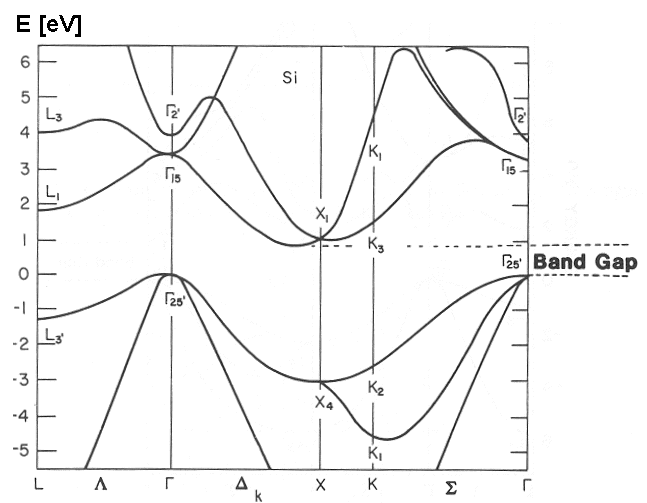
|
The Tutorial structure
Once the tutorial zip file is unzipped the following folder structure will appear
COPYING README Solid_Si/
with the Solid_Si folder containing
ls Solid_Si/ Pwscf/ YAMBO/
- In the Pwscf folder information on the ground state generation are provided. In particular the student will find an input/output directory with input/output files for pw.x. Also a psp folder is provided with the silicon pseudo files.
- The YAMBO folder contains the Yambo input/output files and core databases.
Hartree-Fock
Now we will study the convergence of the Hartree-Fock self energy, respect to the number of G-vectors and k-points. Yambo is a plane-wave code, therefore all the operators and wave-functions are expanded as:
--- File:Orbital2.png --- Test SimpleMathJax: [math]\displaystyle{ \Phi_i({\bf r1}) = \sum_{\bf G}^{N_G} c_i({\bf G}) e^{i{\bf G}\cdot{\bf r}} }[/math] ---
Before you start any calculations we can decide how many G-vectors you want use to represent your wave-function. By default Yambo will use all of them, and for the present tutorial this is fine, however if you are studying larger systems you would like to reduce them in order to speed-up calculations, you can do it with yambo -i -V RL and then changing the variable MaxGvecs that referees to Ng in the previous formula.
Now we will proceed in the calculation of the Hartree-Fock(HF) exchange. This is composed of two terms, that Hartree and the Fock (or exchange) one:
In this tutorial we will calculate only the first order correction to the Kohn-Sham Hamiltonian due to the exchange term. Because of we are working in periodic system, the most appropriate basis to represent the Coulomb potential, appearing in the Fock term, is a plane-wave basis:
In order to generate the input file for the exchange type yambo -x. The variable that governs the number of G vectors Nex in the Coulomb potential is EXXRLvcs. In addition notice that in the previous formula for V(r-r') we have an integral on the q vector, that in the code is discretized on a regular q-grid generated from the k-point one, q=k-k'.
K-points convergence
Enter the YAMBO folder
cd YAMBO/ ls Convergence_Plots 2x2x2 4x4x4 6x6x6 8x8x8 Gamma
Enter each grid folder and run >yambo without options. Then type
yambo -x -F INPUTS/01HF_corrections
and edit the 01HF_corrections file
HF_and_locXC # [R XX] Hartree-Fock Self-energy and Vxc EXXRLvcs= 7 Ry # [XX] Exchange RL components %QPkrange # [GW] QP generalized Kpoint/Band indices 1| 8| 1| 15| % %QPerange # [GW] QP generalized Kpoint/Energy indices 1| 8| 0.0|-1.0| %
setting EXXRLvcs=7 Ry . Then run in each k-point folder
yambo -F INPUTS/01HF_corrections -J HF_7Ry
Note that after the each run Yambo produces three output file, one starting with r_... , another with l_... and a third one starting with o_.... The first one is a report of the actual calculation with all the details of the system, input, and results, while the second is a log with the running time of each process.
The file we are most interested in is the output file, o-HF_7Ry.hf. This file contains several columns. The fourth, labelled with
Ehf represents the Hartree-Fock energy. This is the quantitu we have to look at.
G-vectors convergence
Enter the 4x4x4 folder and edit the 01HF_corrections file changing the field EXXRLvcs=3,6,7 and 15 Ry. For each case run
yambo -F INPUTS/01HF_corrections -J HF_???Ry
with ???=3,6,7 and 15
The results of this series of calculations are summarized in the following plots. Note the rapid convergence with the number of k-points.
To obtain the plots of the following graphs just plot the columns #4-#3 versus #3 of the o.hf files.
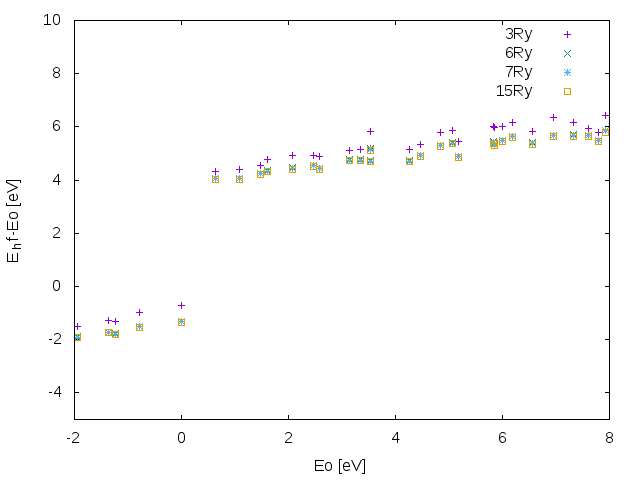
|
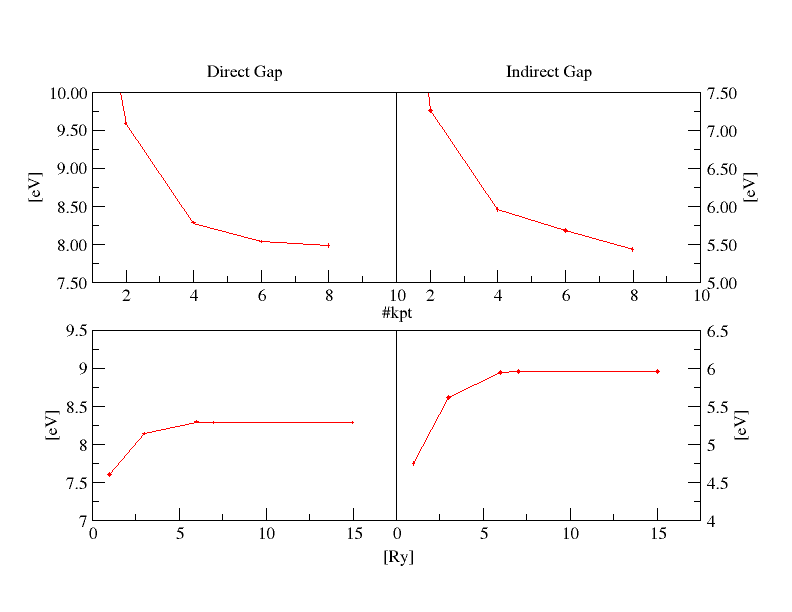
|
COHSEX without empty bands
The Hartree-Fock self-energy just described in the previous section, although successful on some molecular systems, miserably fails in extended systems. The reason of this failure lies in the fact that electrons can screen the Coulomb potential, and therefore one electron feels a screened potential instead of the bare one. A common approximation for this screened potential is the so-called Random Phase Approximation:
where the bare Coulomb potential V(r) is replaced by a non-local and frequency dependent one W(r,r',ω). Subsequently it is possible to redefine all the perturbation theory in term of this screened potential, and disregarding the additional corrections coming from the vertex part, one obtains the so-called GW approximation.
However the substantial complexity associated with calculating the non-local, energy dependent Σ=GW operator inspired early efforts to find simplifying approximations as the static
COHSEX approximation prosed by Hedin[[[4]]]. The Coulomb Hole plus Screened Exchange (COHSEX) approximation[[[2]],3] eliminates the summation over
empty states for the self energy operator and has the added benefit of being a static operator, a particular simplification for self consistent calculations. With the COHSEX approximation the self-energy is
composed of two parts:
where Wp=W - V.
In order to calculate the COHSEX self-energy with yambo you need first the static screened interaction yambo -b -k hartree. As for the V(r) case, also W(r,r',E=0) will
depend from the number of G-vectors, and the k-grid, but this time also the number of conduction bands XsBndsRn will enter in the screening calculation through the polarization function,
see The Interacting response function: Many-Body and TDDFT section.
Notice however that there are not any additional dependence of the self-energy operator from the conduction bands.
After you obtained the screened interaction you are ready to build the self-energy operator and solve the corresponding Dyson equation, have
a look to the Dyson Equation solvers in Yambo. In order to get the quasi-particle energies, just do yambo -b -g n -k hartree.
After calculation are completed Yambo will produce an output file o.qp which contains the values of the bare and re-normalized energy levels.
K-points convergence
Follow the same strategy of the HF case. Enter each k-point folder and type
yambo -b -k hartree -g n -p c -F INPUTS/02Cohsex
edit the input file and change the values of the fields
EXXRLvcs=7 Ry %BndsRnXs 1 | 10 | # [Xs] Polarization function bands % NGsBlkXs= 1 RL # [Xs] Response block size #UseEbands # [GW] Force COHSEX to use empty bands %QPkrange # [GW] QP generalized Kpoint/Band indices 1| 8| 1| 10| %
leaving the other parameters unchanged. Now, in each k-point folder, run
yambo -F INPUTS/02Cohsex -J Cohsex_HF7Ry_X0Ry-nb10
W size convergence
Enter the 4x4x4 folder and edit the 02Cohsex_corrections file changing the field NGsBlkXs=3,6,7 Ry. Run
>yambo -F INPUTS/02Cohsex -J Cohsex_HF7Ry_X???Ry-nb10
with ???=3,6,7 and 15
W bands
Open your input file and change only the input variable NGsBlkXs=1 Ry. Then change
%BndsRnXs
1 | 20 | # [Xs] Polarization function bands
%
and run yambo -F INPUTS/02Cohsex -J Cohsex_HF7Ry_X1Ry-nb20. Repeat the calculations using 30 and 40 bands changing nb???
in the job string identifier. Finally check how the Chosex Direct and Indirect band gap behave as a function of the number of bands in the
screening.
COHSEX with empty bands
While the Screened Exchange(SEX) part of the COHSEX self-energy has a structure similar to the Hartree-Fock exchange term, the Coulomb Hole(COH) acts as static external potential on the electrons. In the COH part the delta function δ(r-r') comes from the completeness relation:
Now we avoid the use of this relation in such a way to have a self-energy that depends from the conduction bands too. This can be done uncommenting flags UseEbands and setting the number of bands in the Green's function:
% GbndRnge
1 | 10 | # [GW] G[W] bands range
%
Repeat the previous calculations with different GbndRnge for instance, 10 20 30 40, and check how the COHSEX direct and indirect band gap behave as a function of the number of bands in the Green's function.
Recently an enhanced version of the COHSEX approximation has been proposed, if you want learn more have a look to the reference[[[4]]].
The plasmon pole approximation
Even the static COHSEX approximation is very appealing, it was clear from the first calculation that dynamical effects cannot be disregarded in solids[[[6]]]. This fact motivated the research for approximated way to deal with a frequency dependent interaction, and one of the first proposal was the so-called Plasmon-Pole Approximation (PPA) (see ref. [[[7]]]).
Now we will proceed to the calculation of the silicon band gap in G0W0 within PPA. In each section you will be asked to perform several calculations
varying the value of the relevant variables involved. More specifically let's consider a typical Yambo input file to calculate GW corrections in the PPA.
gw0 # [R GW] GoWo Quasiparticle energy levels
ppa # [R Xp] Plasmon Pole Approximation
HF_and_locXC # [R XX] Hartree-Fock Self-energy and Vxc
em1d # [R Xd] Dynamical Inverse Dielectric Matrix
EXXRLvcs= 7 Ry # [XX] Exchange RL components
% QpntsRXp
1 | 8 | # [Xp] Transferred momenta
%
% BndsRnXp
1 | 30 | # [Xp] Polarization function bands
%
NGsBlkXp= 7 Ry # [Xp] Response block size
% LongDrXp
1.000000 | 0.000000 | 0.000000 | # [Xp] [cc] Electric Field
%
PPAPntXp= 27.21138 eV # [Xp] PPA imaginary energy
% GbndRnge
1 | 30 | # [GW] G[W] bands range
%
GDamping= 0.10000 eV # [GW] G[W] damping
dScStep= 0.10000 eV # [GW] Energy step to evalute Z factors
DysSolver= "n" # [GW] Dyson Equation solver (`n`,`s`,`g`)
%QPkrange # [GW] QP generalized Kpoint/Band indices
1| 8| 1| 10|
%
%QPerange # [GW] QP generalized Kpoint/Energy indices
1| 8| 0.0|-1.0|
%
The variables are the same of the COHSEX case plus a new one PPAPntXp that describes the imaginary energy used to fit the Plasmon Pole model.
Follow the same strategy of the COHSEX case. Enter each k-point folder and type:
yambo -d -k hartree -g n -p p -F INPUTS/03GoWo_PPA_corrections
otherwise you can use the existent file Input/03GoWo_PPA_corrections.
Now you have to study the convergence of the G0W0 gap versus the number of k-points, the number of
bands in χ BndsRnXs, the size of the dielectric constant NGsBlkXs and the number of bands in the Green's function GbndRnge.
Please follow the same strategy of the COHSEX case running yambo using
yambo -F INPUTS/03GoWo_PPA_corrections -J GoWo_PPA_HF7Ry_X???Ry-nb???_nb???
The final convergence plots should look like these.
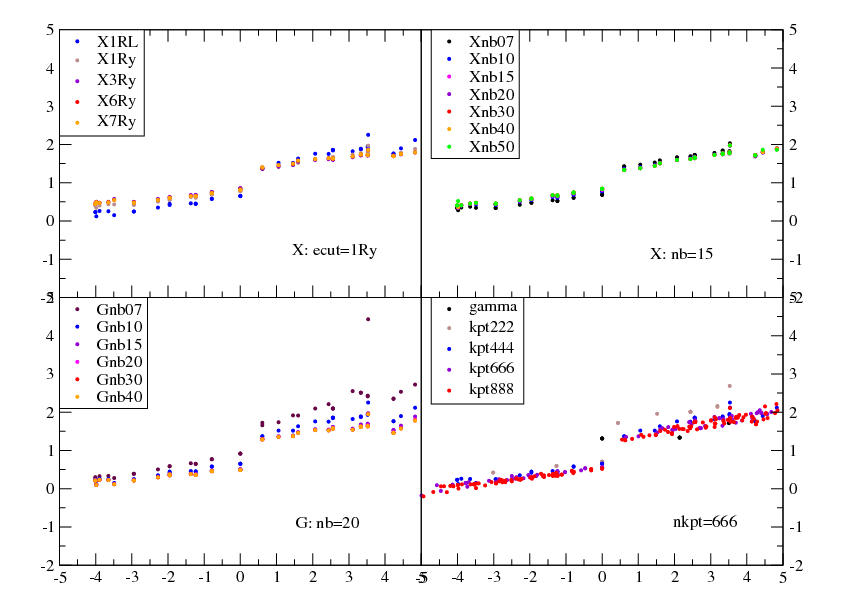
|
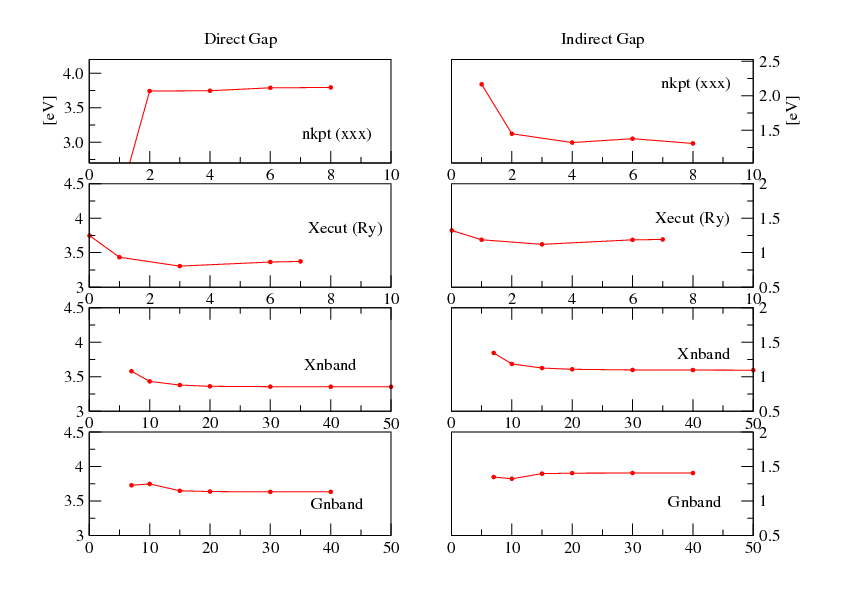
|
Final runs!! Now you know how to converge a G0W0 calculation so you can decide which are the parameters needed for full convergence. First do a COHSEX and then a GoWo (PPA) run at convergence, and you should obtain results similar to the following graph:
Curiosity: What's happen if the PPA fails? Have a look to the tutorial on the Real-Axis Integration.
References
- Silicon on Wikipedia.
- Electron Correlation in the Solid State, Norman H. March (1999).
- GW approach to the calculation of electron self-energies in semiconductors, B. Farid et al., Phys. Rev. B 38, 7530 (1988).
- New Method for Calculating the One-Particle Green's Function with Application to the Electron-Gas Problem L. Hedin, Phys. Rev. 139, A796 (1965).
- Enhanced Static Approximation to the Electron Self-Energy Operator for Efficient Calculation of Quasiparticle Energies, Wei Kang, Mark S. Hybertsen, Phys. Rev. B 82, 195108 (2010).
- Dynamical Correlation Effects on the Quasiparticle Bloch States of a Covalent Crystal, G. Strinati, H. J. Mattausch, and W. Hanke , Phys. Rev. Lett. 45, 290 (1980).
- Space-time method for ab initio calculations of self-energies and dielectric response functions of solids, H. N. Rojas, R. W. Godby, and R. J. Needs, Phys. Rev. Lett. 74, 1827 (1995) .
